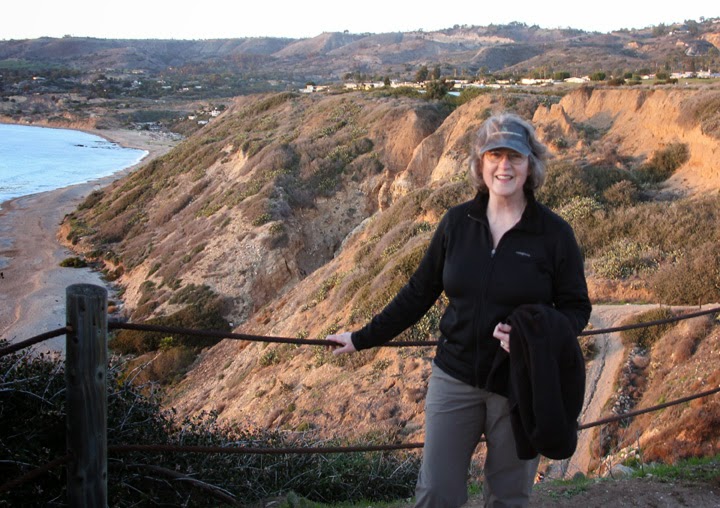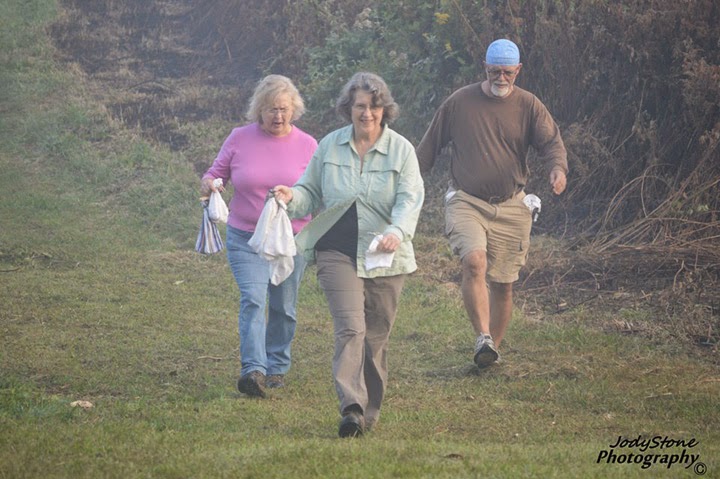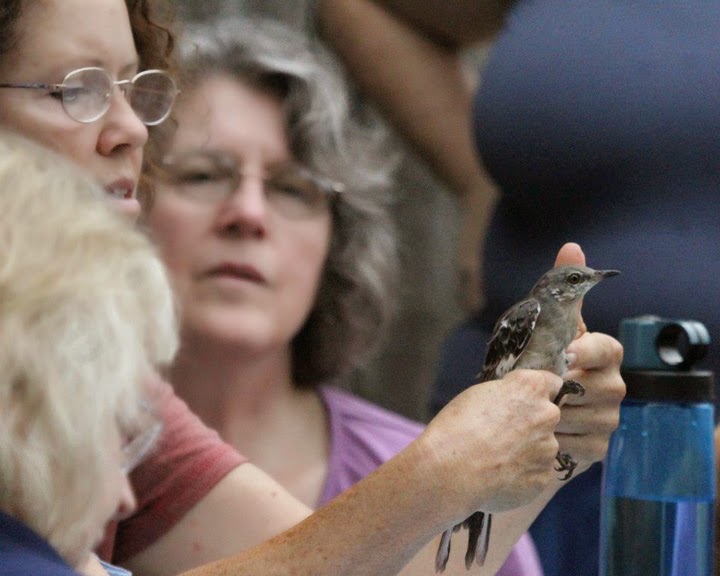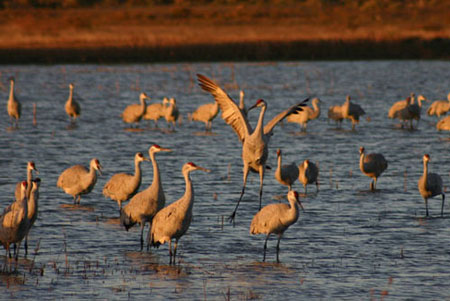 Yesterday, March 30th, I visited my favorite Knoxville hawks again. In southeast Tennessee redbud are peppering the hillsides with magenta pink. Dogwood are opening, bluebirds singing and in red-shouldered hawk territory, yellow jasmine and trillium are in bloom.
Yesterday, March 30th, I visited my favorite Knoxville hawks again. In southeast Tennessee redbud are peppering the hillsides with magenta pink. Dogwood are opening, bluebirds singing and in red-shouldered hawk territory, yellow jasmine and trillium are in bloom. But what caught my attention on this visit even more, the new greenery that now conspicuously decorates the hawk's nest. In the image below, the female is incubating on the nest. All around her you can see sprigs of green pine needles. Notice, also, the downy white feathers scattered about.
But what caught my attention on this visit even more, the new greenery that now conspicuously decorates the hawk's nest. In the image below, the female is incubating on the nest. All around her you can see sprigs of green pine needles. Notice, also, the downy white feathers scattered about. Females are known to pluck feathers from the 'sweet spot', the place on their breast that makes contact with the eggs during incubation. This allows for more warmth to the eggs, as well as providing a downy material to tuck into the nest for softness.
Females are known to pluck feathers from the 'sweet spot', the place on their breast that makes contact with the eggs during incubation. This allows for more warmth to the eggs, as well as providing a downy material to tuck into the nest for softness.I have marveled on more than one occasion at the synchronous cooperation between these two hawks, the innate knowledge that moves them to cooperate, to hold tight to the nest, to share their food. Just what prompts raptors to add fresh greens to the nest while incubating is uncertain. Biologists speculate that the aroma may deter insects. Others have referred to this as an announcement to other raptors that this nest is occupied.
 Above you see the female carrying prey, a squirrel that the male has brought her. At the moment she comes to his perch for the food, the male zooms back to the nest to take over incubation. More details on how this cooperation works, coming up.
Above you see the female carrying prey, a squirrel that the male has brought her. At the moment she comes to his perch for the food, the male zooms back to the nest to take over incubation. More details on how this cooperation works, coming up. Bottom photo, trillium; top photo, jasmine; second image, eastern bluebird male on dogwood.
Bottom photo, trillium; top photo, jasmine; second image, eastern bluebird male on dogwood.This post is part of a series on a nesting pair of red-shouldered hawks. To see the entire series, click here.






 This stunning female cardinal landed on the
This stunning female cardinal landed on the 

 And just as I was thinking, I'm not going to see the male hawk today, I looked beyond the cardinal and there he was, perched high in a tree to my back while I was
And just as I was thinking, I'm not going to see the male hawk today, I looked beyond the cardinal and there he was, perched high in a tree to my back while I was  Next: Domestic duties, hawk style.
Next: Domestic duties, hawk style.

 Once on the ground he immediately began to hop among the leaves, pausing only once to listen to the camera click.
Once on the ground he immediately began to hop among the leaves, pausing only once to listen to the camera click.




 These words struck me as so important. Hawk pair bonding represents a dramatic change in the basic behavior of a bird that is, by nature, a solitary predator. This behavioral shift is the principle glue that enables nest building, copulation and partnered responsibility during incubation and the raising of young.
These words struck me as so important. Hawk pair bonding represents a dramatic change in the basic behavior of a bird that is, by nature, a solitary predator. This behavioral shift is the principle glue that enables nest building, copulation and partnered responsibility during incubation and the raising of young. And now, you may cover your eyes if you wish. I have given fair introduction to the activity you are about to witness through images. Copulation is the natural event that precedes fertile egg-laying. If I could show you egg-laying, I would, as well.
And now, you may cover your eyes if you wish. I have given fair introduction to the activity you are about to witness through images. Copulation is the natural event that precedes fertile egg-laying. If I could show you egg-laying, I would, as well.





 While they rested, I remembered to breathe and continued to click the shutter. Can there be any more surprises? Well...yes.
While they rested, I remembered to breathe and continued to click the shutter. Can there be any more surprises? Well...yes. And because disease in your own backyard feels personal, I was interested in this
And because disease in your own backyard feels personal, I was interested in this  The report also states that outbreaks of disease occur periodically and though the reasons aren't clearly understood, it happens. This, of course, doesn't answer all our questions or dissolve the discomfort of finding diseased birds at your feeders, but at least it is more information. What feels very personal in the beginning gradually becomes another phenomenona of nature that disserves observation and research.
The report also states that outbreaks of disease occur periodically and though the reasons aren't clearly understood, it happens. This, of course, doesn't answer all our questions or dissolve the discomfort of finding diseased birds at your feeders, but at least it is more information. What feels very personal in the beginning gradually becomes another phenomenona of nature that disserves observation and research.
 I had just opened up my watercolor sketch kit and begun to paint when a hawk called and flew past me. Now, when I say flew past me, I'm not describing a great distance. He flew past me within 10-12 feet. I now realize, in hindsight, that where I normally sit provides a front row seat to the pair's activities, a location right beside their flight path and several favorite perches. How lucky can one person get?
I had just opened up my watercolor sketch kit and begun to paint when a hawk called and flew past me. Now, when I say flew past me, I'm not describing a great distance. He flew past me within 10-12 feet. I now realize, in hindsight, that where I normally sit provides a front row seat to the pair's activities, a location right beside their flight path and several favorite perches. How lucky can one person get?



 I watched the female eat her food offering. This was clearly a prey exchange, one of the behavioral rituals that bonds a mated pair of hawks during the breeding season. When the female finished eating, she picked up the inedible remains and dropped them over the side of the limb.
I watched the female eat her food offering. This was clearly a prey exchange, one of the behavioral rituals that bonds a mated pair of hawks during the breeding season. When the female finished eating, she picked up the inedible remains and dropped them over the side of the limb.
 Above, she checks her perch for any other remains and cleans her bill, below.
Above, she checks her perch for any other remains and cleans her bill, below.

 Next: The male returns.
Next: The male returns. This pair of hawks has nested in the area for years and is accustomed to people coming and going. Another human presence is nothing new or alarming. However, I am very aware that I am a visitor in their territory and that they see me far sooner and with more scrutiny than I can ever see them. My desire is to observe their natural behavior as much as time and timing will allow. And so, I am careful to not disturb, to be as still, quiet, slow moving and deliberate as possible, and to keep a respectful distance when I do know their location.
This pair of hawks has nested in the area for years and is accustomed to people coming and going. Another human presence is nothing new or alarming. However, I am very aware that I am a visitor in their territory and that they see me far sooner and with more scrutiny than I can ever see them. My desire is to observe their natural behavior as much as time and timing will allow. And so, I am careful to not disturb, to be as still, quiet, slow moving and deliberate as possible, and to keep a respectful distance when I do know their location. The hawk continued to call so I searched through the tangle of limbs along the border of the property and into the next yard and movement caught my eye.
The hawk continued to call so I searched through the tangle of limbs along the border of the property and into the next yard and movement caught my eye. The back lighting produced a silhouette image, but I snapped photos anyway, knowing I might learn more through the images. As I looked through the lens, I could see sticks, lots of sticks and realized I was looking at the nest. (
The back lighting produced a silhouette image, but I snapped photos anyway, knowing I might learn more through the images. As I looked through the lens, I could see sticks, lots of sticks and realized I was looking at the nest. ( The nest is relatively small and certainly inconspicuous. In the above photo, you can see the hawk placing lichen, moss, leaves, some kind of leafy matter in the nest. I suspect this is for the soft lining, though its impossible to know. Though the photo is poor, it at least confirms that this isn't a 'maybe' alternative nest, but their choice for the season.
The nest is relatively small and certainly inconspicuous. In the above photo, you can see the hawk placing lichen, moss, leaves, some kind of leafy matter in the nest. I suspect this is for the soft lining, though its impossible to know. Though the photo is poor, it at least confirms that this isn't a 'maybe' alternative nest, but their choice for the season. After I was sure the hawk was gone, I took the opportunity to walk around to the other side of the nest to see how it was positioned in the tree and to get a better look without the glare. Notice, below, how difficult the nest is to see, even when you know where to look. Follow the two large limbs (at the top) down to the formation of the main trunk. The cluster of rust leaves hang underneath the nest.
After I was sure the hawk was gone, I took the opportunity to walk around to the other side of the nest to see how it was positioned in the tree and to get a better look without the glare. Notice, below, how difficult the nest is to see, even when you know where to look. Follow the two large limbs (at the top) down to the formation of the main trunk. The cluster of rust leaves hang underneath the nest.  This is what you see if you look for the nest. It is positioned in a spot where more than one tree comes together to form the support platform. And from any view from the ground, very little of the nest is visible. Soon leaves will be popping and I suspect it won't be visible at all.
This is what you see if you look for the nest. It is positioned in a spot where more than one tree comes together to form the support platform. And from any view from the ground, very little of the nest is visible. Soon leaves will be popping and I suspect it won't be visible at all.







